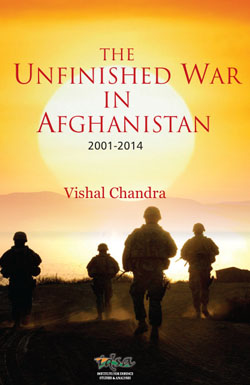The Unfinished War in Afghanistan: 2001-2014
- 2014 |
- Book

About the Book
This book makes a modest attempt to contribute to the ongoing debate on future challenges for Afghanistan as the largest ever coalition of Western forces prepares to withdraw. It seeks to examine key political developments within Afghanistan over the last one decade in response to the US-led Western military and political intervention. Perhaps, much more is still to come in a war that could aptly be termed as the last big war of the twentieth and first long war of the twenty-first century. The emerging social and political narratives are unmistakably old and echo the sentiments of the past. Though a ‘New Afghanistan’ has emerged in the meanwhile, it remains fundamentally an urban phenomenon. The diversity of narratives and perceptions, and failure of past political transitions to build a sustainable internal balance of power, based on changed social and political realities, have turned Afghanistan into a complex entity that defies established theoretical formulations and explanations. The evolving security and political scenario suggests that elections alone may not help bring stability and order to Afghanistan. The next dispensation in Kabul, irrespective of its composition, is most likely to be confronted with a host of old and familiar challenges to its legitimacy and survival.
About The Author
Vishal Chandra is Associate Fellow at the Institute for Defence Studies & Analyses (IDSA), New Delhi. His core area of research is politics of Afghan conflict, with special interest in Taliban resurgence, politics of reconciliation, making of the Afghan National Army, role of political opposition, shaping of regional perceptions, past political transitions and trends in Indo-Afghan relations.
He has travelled widely in Afghanistan and has attended various international conferences and workshops on Afghanistan. He regularly lectures on Afghan affairs and is member of several policy groups on Afghanistan. With more than a decade of research experience, he has over 40 publications on Afghanistan, including 15 book chapters and several articles and commentaries, to his credit. He has edited the book, India’s Neighbourhood: The Armies of South Asia (Pentagon Press, New Delhi, 2013).
Reviews on the book: Journal of Slavic Military Studies (Routledge, July-September 2015 issue), India Today/Mail Today (March 08, 2015), The Pioneer (Sunday Edition, March 08, 2015), The Book Review (February 2015), The New Straits Times (Kuala Lumpur, January 2015), Indian Foreign Affairs Journal (October-December 2014), Amar Ujala (Hindi, Sunday Edition, March 22, 2015) and Nai Dunia (Hindi, January 2015)
Click here for detailed profile of the author
Contents
Foreword
Acknowledgements
Abbreviations
List of Tables and Maps
Afghanistan: Key Socio-Economic Indicators
Introduction
-
- New Order, Old PoliticsAn Abandoned and Forgotten WarRecasting Old Fault LinesMujahideen within Local Structures
Return of Old Militia Networks
Debating the New Constitution
- Tryst with DemocracyThe First Election (2004-05)President Elect and the First CabinetAssessing the Bonn Process
Karzai’s Re-election: Chaotic Exercise
Prospects of Democracy
- Opposition Politics and Karzai the Master SurvivorEvolution of NFAThe National Understanding Front
Composition and Agenda of NFAReactions to the Emergence of the NFANFA and the Taliban
New Turf War Begins
Karzai the Master Survivor
- Taliban Back into Power PlayWar on Terror: Losing while WinningTaliban No More on the FringeGaining Strategic Depth in Pakistan
Changing Face of the Afghan War
Western Mission Going Nowhere
- Politics of Taliban Reconciliation and Reintegration Growing AmbiguityMaking of the IdeaKey Challenges
Future Prospect
- Quest for a National ArmyOrigin/Evolution of the New National ArmyTraining and MentoringStructure/Formation of ANA
Afghan National Army Air Corps (ANAAC)Ethnic Representation
Funding
Rushing for Numbers
The Weaponry
Multiple Challenges
Future Prospects
- The ‘Other’ Key Neighbours – Iran, India, China and Russia
- New Order, Old PoliticsAn Abandoned and Forgotten WarRecasting Old Fault LinesMujahideen within Local Structures
Pakistan: Terrorism without Terrorists!
Iran: A Dominant Factor
India: Partner in Development
China: Pretending Distance
Russia: Hesitant but Concerned
Awaiting ‘Post-2014’ Afghanistan
- The Unfinished War
Beyond 2014: Continuing Concerns and Challenges
(i) Historical Conflict Dynamics
(ii) Post-Karzai Leadership
(iii) US’ Missing Future Strategy
(iv) Survival of the National Army
(v) Resilience of the Taliban
APPENDICES
- Agreement on Provisional Arrangements in Afghanistan Pending the Re-establishment of Permanent Government Institutions
- North Waziristan Peace Pact
- White Paper of the Interagency Policy Group’s Report on U.S. Policy Toward Afghanistan and Pakistan
- Status of ANAAC (as of April 2010)
Index
Order Hard Copy
Please email us at publication [at] idsa.in or call +91-11-2671 7983 (Ext. 7303)






